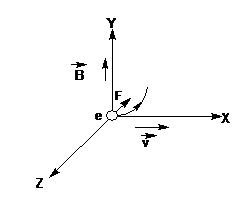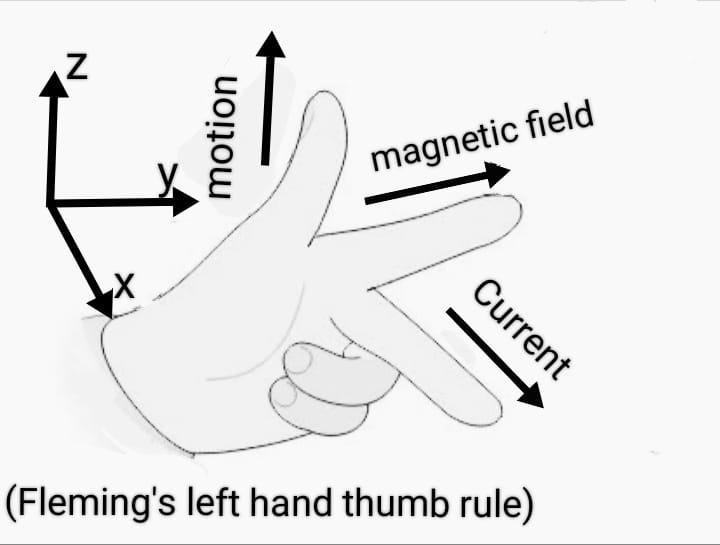
An electron moving with a uniform velocity along the positive $x-$direction enters a magnetic field directed along the positive $y-$direction. The force on the electron is directed along
A. Positive $y-$direction
B. Negative $y-$direction
C. Positive $z-$direction
D. Negative $z-$ direction
Answer
218.4k+ views
Hint: When an electron is moving along the $x-$direction, it enters a magnetic field directed along the positive$y-$direction. If an $x-$axis and $y-$axis are perpendicular to each other, then the direction of the magnetic force acting on the particle is given by Fleming’s left-hand thumb rule.
Formula used:
The radius,$R$ of the circular path in a magnetic field,$B$can be expressed in the following way:
$R=\dfrac{mv}{qB}$
Here $m\And v$are the mass and velocity of the particle with charge $q$.
Complete answer:
Consider the unit vectors in $x,y\And z$ the direction be $\hat{i},\hat{j}\And \hat{k}$. Since it is given, the charged particle moves along $x-$ direction with a uniform velocity and the magnetic field $\vec{B}$along $y-$ direction.

When a particle carrying charge$q$, moving with uniform velocity $\vec{v}$enters into a magnetic field $\vec{B}$, it experiences a magnetic force,$\vec{F}=q(\vec{v}\times \vec{B})$
$\therefore \vec{F}=q(v\hat{i}\times B\hat{j})$
$\vec{F}=-e(v\hat{i}\times B\hat{j})$
$\vec{F}=evB(-\hat{k})$
Hence the force acting on the electron is directed along the negative $z-$direction.
The overall phenomena can be better understood by Fleming’s left-hand thumb rule.
This rule tells us if we stretch our index, middle finger, and thumb in such a way that they are mutually perpendicular to each other, the index finger points the direction of the magnetic field along $y-$ the direction and the middle finger shows the direction of current along $x-$the direction, then the thumb will point the subsequent direction of the magnetic force along the positive $z-$direction.

But here the particle is a negatively charged electron, magnetic force acts along the negative $z-$direction.
Thus, option (D) is correct.
Note:Protons and electrons both are particles with same charge, when they move in the magnetic field , will experience the same magnitude of magnetic force but in the opposite direction. As we know the mass of an electron is less than that of a proton hence the electron will get deflected by a higher degree than the proton.
Formula used:
The radius,$R$ of the circular path in a magnetic field,$B$can be expressed in the following way:
$R=\dfrac{mv}{qB}$
Here $m\And v$are the mass and velocity of the particle with charge $q$.
Complete answer:
Consider the unit vectors in $x,y\And z$ the direction be $\hat{i},\hat{j}\And \hat{k}$. Since it is given, the charged particle moves along $x-$ direction with a uniform velocity and the magnetic field $\vec{B}$along $y-$ direction.

When a particle carrying charge$q$, moving with uniform velocity $\vec{v}$enters into a magnetic field $\vec{B}$, it experiences a magnetic force,$\vec{F}=q(\vec{v}\times \vec{B})$
$\therefore \vec{F}=q(v\hat{i}\times B\hat{j})$
$\vec{F}=-e(v\hat{i}\times B\hat{j})$
$\vec{F}=evB(-\hat{k})$
Hence the force acting on the electron is directed along the negative $z-$direction.
The overall phenomena can be better understood by Fleming’s left-hand thumb rule.
This rule tells us if we stretch our index, middle finger, and thumb in such a way that they are mutually perpendicular to each other, the index finger points the direction of the magnetic field along $y-$ the direction and the middle finger shows the direction of current along $x-$the direction, then the thumb will point the subsequent direction of the magnetic force along the positive $z-$direction.

But here the particle is a negatively charged electron, magnetic force acts along the negative $z-$direction.
Thus, option (D) is correct.
Note:Protons and electrons both are particles with same charge, when they move in the magnetic field , will experience the same magnitude of magnetic force but in the opposite direction. As we know the mass of an electron is less than that of a proton hence the electron will get deflected by a higher degree than the proton.
Recently Updated Pages
Young’s Double Slit Experiment Derivation Explained

Wheatstone Bridge Explained: Working, Formula & Uses

Chemical Properties of Hydrogen - Important Concepts for JEE Exam Preparation

JEE General Topics in Chemistry Important Concepts and Tips

JEE Atomic Structure and Chemical Bonding important Concepts and Tips

JEE Amino Acids and Peptides Important Concepts and Tips for Exam Preparation

Trending doubts
JEE Main 2026: Application Form Open, Exam Dates, Syllabus, Eligibility & Question Papers

Derivation of Equation of Trajectory Explained for Students

Hybridisation in Chemistry – Concept, Types & Applications

Understanding the Angle of Deviation in a Prism

Understanding Collisions: Types and Examples for Students

Understanding Atomic Structure for Beginners

Other Pages
JEE Advanced Marks vs Ranks 2025: Understanding Category-wise Qualifying Marks and Previous Year Cut-offs

How to Convert a Galvanometer into an Ammeter or Voltmeter

Understanding Centrifugal Force in Physics

Ideal and Non-Ideal Solutions Explained for Class 12 Chemistry

Degree of Dissociation: Meaning, Formula, Calculation & Uses

Understanding Electromagnetic Waves and Their Importance




